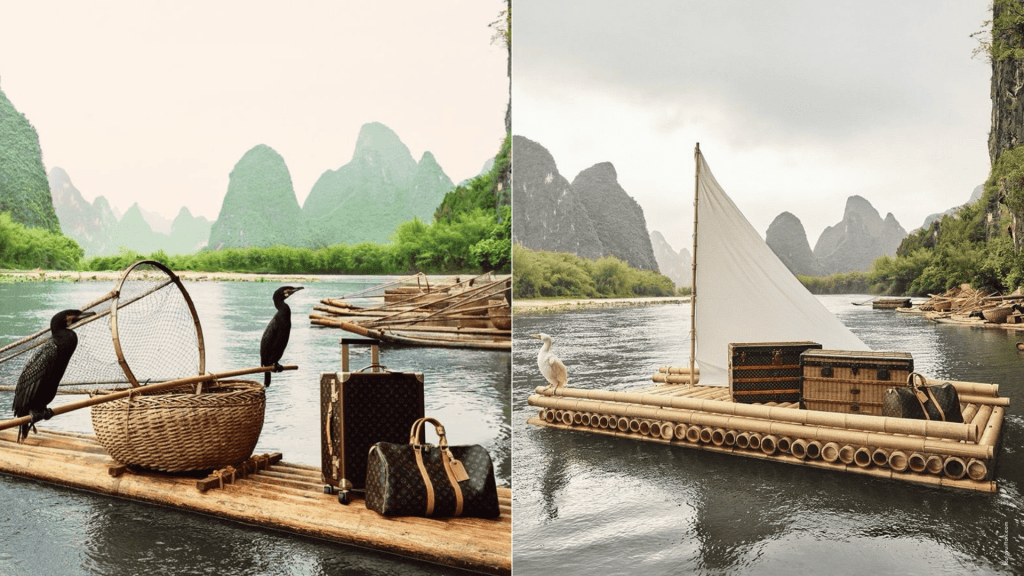Our Terms & Conditions | Our Privacy Policy
Why Louis Vuitton’s latest China campaign is tone-deaf
In Guangxi, China, a fisherman practising the centuries-old tradition of cormorant fishing can earn less in his entire lifetime than the price of a single Louis Vuitton trunk. Yet in Louis Vuitton’s recent campaign, that trunk is perched proudly on the fisherman’s raft, without the fisherman himself in sight.
The campaign, now making the rounds on social media, has been praised for its atmospheric beauty. It is visually impressive, but the reality it omits makes the beauty ring hollow.
The disappearing tradition
Related Article Block Placeholder
Article ID: 304771
Cormorant fishing is a traditional technique, commonly associated with the Bai people in Guangxi. In this practice, fishermen train cormorants to catch fish and return them to the boat, a skill passed down through generations. The method is slow and yields far less than modern industrial fishing.
Because of its inefficiency, many cormorant fishermen now earn barely enough to survive. Harsh weather, physical strain, and dwindling fish populations have pushed the tradition to the brink of disappearance. Those who remain often rely on tourism income, posing for photos and taking visitors out on the river, to supplement their meagre earnings.
What is missing from Louis Vuitton’s picture
The campaign removes the human element entirely. The real fishermen, whose lives and labour give meaning to these river scenes, are nowhere to be seen. Instead, their rafts have been repurposed as props to carry piles of luxury suitcases, items they could never afford, even with a lifetime’s earnings.
Smarter business news. Straight to your inbox.
For startup founders, small businesses and leaders. Build sharper instincts and better strategy by learning from Australia’s smartest business minds. Sign up for free.
By continuing, you agree to our Terms & Conditions and Privacy Policy.
Without the people, the tradition becomes a hollow aesthetic. It is an image that commodifies culture while erasing the very communities that sustain it.
 Source: Louis Vuitton
Source: Louis Vuitton
A jarring juxtaposition
Placing luxury goods alongside scenes of near-poverty creates a contrast that is hard to ignore. Luxury fashion is built on excess, on the idea that you can afford something purely for the pleasure of owning it. But to juxtapose that excess with symbols of subsistence and survival is to highlight the gulf between rich and poor in the starkest possible terms.
Related Article Block Placeholder
Article ID: 319438

Imagine the reality: the majority of Louis Vuitton customers are unlikely to arrive in Guangxi hauling their trunks through river shallows. They would hire locals, often at low pay, to porter those heavy suitcases. The locals would push through the rocks, load the bags, and carry the weight while visitors enjoy the scenery. In this way, the campaign’s imagery is not only tone-deaf, it mirrors the very exploitation it romanticises.
Cultural appropriation dressed as luxury
This is a textbook case of cultural appropriation in luxury marketing. A brand extracts the aesthetic of a culture, its symbols, landscapes, and traditional practices, but removes the actual people and their stories. It profits from the beauty of a place while giving nothing back to its community.
The harm is not only economic but symbolic. By stripping away context, the campaign flattens a rich cultural practice into a decorative backdrop. It denies the community any narrative agency and instead imposes the brand’s own vision of what is “beautiful” or “aspirational”.
Beauty without responsibility is exploitation
The Louis Vuitton campaign has achieved one kind of success, because people are talking about it. But conversation without accountability is empty. Beautiful imagery means little if it reinforces inequality, strips communities of their stories, and profits from cultures while leaving them materially unchanged.
Luxury brands, in particular, have both the resources and the influence to do better. They can choose to elevate the communities they feature, or they can continue to treat those communities as set pieces in someone else’s fantasy.
In Guangxi, the fishermen still rise before dawn, guiding their cormorants out into the mist. The work is hard, the pay is low, and the future of the tradition is uncertain. A Louis Vuitton trunk on a fisherman’s raft makes for a striking image, but without the fisherman, without his story, and without any benefit to him or his community, it is just another luxury accessory: beautiful, expensive, and ultimately empty.
Images are for reference only.Images and contents gathered automatic from google or 3rd party sources.All rights on the images and contents are with their legal original owners.



Comments are closed.